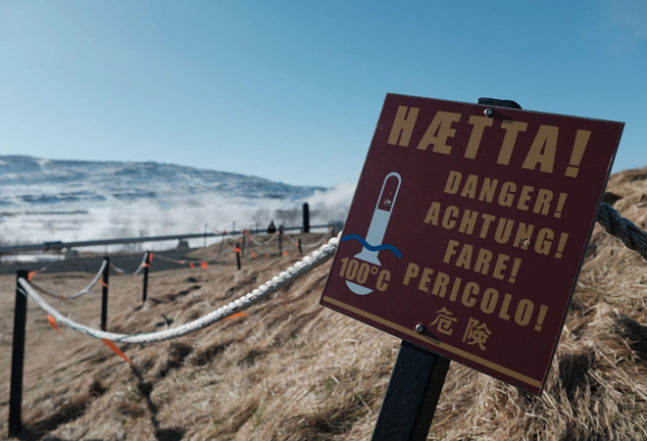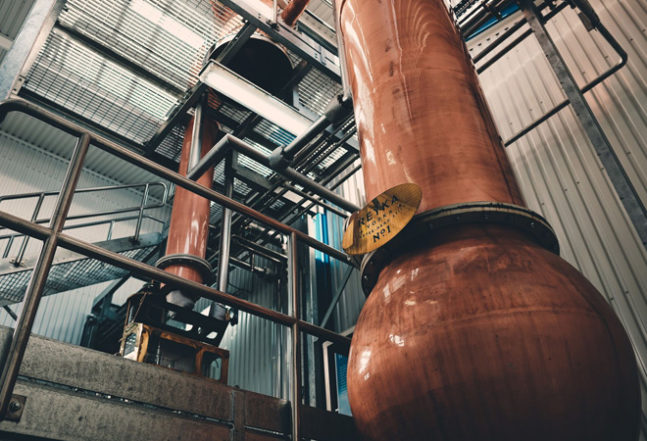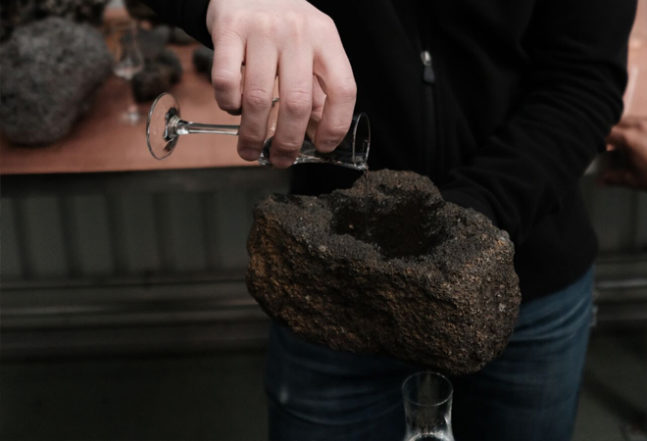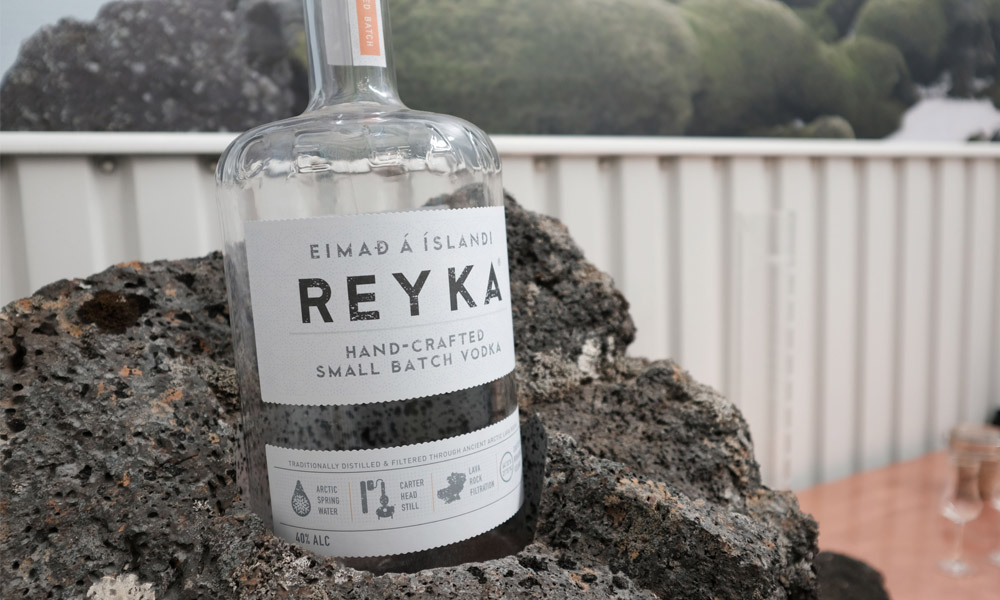Reyka Vodka has garnered a reputation as being one of the purest vodkas in the world. Of course, that’s quite a distinction; one some more discernible boozehounds might find suspect. We traveled with the Reyka team to their distillery, located roughly an hour north of Reykjavík in the beautiful rural town of Borganes, to better understand the praise heaped on the label.
When we arrived at the distillery, Reyka Master Distiller Thordur Sigurdsson greeted us at the tiny door in the back. The minute we were inside, we were immersed in all the action. No kitschy gift shops to walk through, no preliminary history lectures, and no bottle-lined lobby. There’s something to be said about a distillery tour that starts and ends in one room, and focuses on the good stuff instead of the fluff.
Sigurdsson stressed five key points in terms of what makes Reyka Vodka so special: Their pure Icelandic glacier water, the lava filtration, the Carter-Head Still, the use of geothermal pre-heating, and their physical geographic location.
And that is where this story begins.

Booze Meets Science Through Geothermal Heat
On the whole, Iceland isn’t just an absolutely gorgeous country with snowcapped mountains, glaciers, springs, and geysers galore; it’s a country that acknowledges its natural beauty and goes to great lengths to preserve it. In fact, it’s one of the only countries in the world that can say it obtains 100% of its electricity and heat from renewable sources—mainly geothermal and hydropower.
Naturally, the Reyka Vodka distillery follows suit. What makes Reyka unique is that when their neutral grain spirit is placed into the still, it’s preheated using geothermal energy (which also powers the entire distillery) that comes as a byproduct of the area’s volcanically heated groundwater. The preheating of the neutral grain spirit ensures a specific reaction in the still, and is essential to the overall final product.
Once the geothermal preheating of the neutral grain spirit is done, the water then cycles through the distillery to provide power and heat. It’s all totally emissions free, which translates simply to, “This is some of the cleanest booze on the planet in every damn sense of the word.”

The Magic of the Carter-Head Still
Does it sound like the title of a J.K. Rowling novel? Maybe. But it’s true. The Carter-Head still is considered one of the best, rarest, and unique stills on the planet, and so much of Reyka’s characteristic flavor profile comes as a direct result of it being distilled in one of these bad boys. There are only six in the entire world, and of them, Reyka is the only company using one to produce vodka.
The copper from this still design rectifies the neutral grain spirit differently than other stills, resulting in a lighter, crisper, and more vibrant flavor profile. It’s for this reason Carter-Head stills are popular in gin distillation, and part of the reason why Reyka uses it as the vessel by which their vodka is created.
The other part is because at the top of the Carter-Head still’s giant column, just following the vapor pipe, lies something called a botanical basket. In gin production, this is exactly what it sounds like. The botanicals that give gin its juniper-y, citrus-y, and floral-y flavors go inside the box, and the spirit is passed through and thus infused with those flavors.
However, at some point, someone had the ingenious idea to incorporate that into Reyka’s distillation process, only the botanical box is filled with purifying lava rock.

Lava Rock and Some of the Purest Water on Earth
Because Reyka prides itself on its all-natural clean production process, they use locally sourced lava rock to filter out impurities after the vapor from the still is turned back into a liquid. Every drop of that liquid passes through the lava rock-filled botanical box, and is even filtered again later on down the line just to make sure the spirit is pure as can be.
And while the botanical box is the first time the spirit will filter through lava rock, it’s important to note the glacial water with which the neutral grain spirit is blended passes through an entire field of lava rocks. That water is sourced from one of Iceland’s many springs, Grábrók. Grábrók is important because the legendary spring’s water flows through a 4,000-year-old lava rock field, making it some of the purest water in the entire world. For Reyka Vodka, it means no strange minerality, weird flavors, or impurities make their ways into the final product.
Oh, and for context’s sake, we think it’s worth mentioning that adding water is an integral part of making Reyka Vodka (and many other spirits, for that matter) what it is. Because barley doesn’t grow well in Iceland’s tough climate and less-than-ideal soil, they source their neutral grain spirit from Scotland. (Actually, quick fun fact: It’s the same barley-based neutral grain spirit used in Hendrick’s Gin. Just goes to show how important the distillation process is, eh?)
When the neutral grain spirit arrives at Reyka, it’s a whopping 96% alcohol, which means it’s roughly 192 proof. For comparison, good white lightning moonshine is somewhere around 160 proof or so. Filtered glacial water from Grábrók is added to it in the still to bring it down to 70% alcohol, which makes it 140 proof. After the distillation occurs and some of the water is lost (it turns to steam and evaporates in the process), the purified spirit is roughly 92% alcohol, or 184 proof. Finally, that spirit is blended with yet more filtered glacial water, which brings it down to its final product, 40% alcohol or 80 proof, which is what gets bottled and sold worldwide.
The key here is that when it comes to your whiskies or bourbons or rums (a rule of thumb is anything that isn’t clear), there’s an aging process, whereby the distilled spirit is matured in casks for years until enough alcohol evaporates (AKA, the angels share) to make it acceptable to bottle and sell. So, a rum that goes into a cask at 90% alcohol is then aged in barrels for XX years, where XX% of the alcohol evaporates out of the spirit, where it is then shipped off for bottling.
Vodka traditionally isn’t barrel-aged at all, which makes blending with water essential to the process.
Small Batches Mean More Attention to Detail
Reyka Vodka has been on our radar for years, which made just how small their operation is all the more surprising. There’s one small building, one still, and literally two people at the helm of the entire Reyka Vodka distillation process, but what Reyka “lacks” in production volume, they make up for in quality.
One whole distillation process takes between five and six hours, and yields a grand total of 3,000 liters of Reyka Vodka per day. That translates to roughly only 115,000 9-liter cases every year. Since that number is probably meaningless to you, for comparison’s sake, household major label Sailor Jerry Spiced Rum manufactures 750,000 9-liter cases every year, which means there’s over 6.5 times more Sailor Jerry Spiced Rum being boxed and sold every year than Reyka Vodka.
The “small batch” distinction on Reyka’s label is indeed an accurate one.
Naturally, that translates to more intimate quality assurance standards. In one distillation process, Sigurdsson separates the harsher head and tail of the vodka from the heart, which is the stuff that eventually gets blended with glacial water and then bottled. How does he tell the difference? Taste and smell. Seriously, that is the scientific process by which Reyka’s quality is gauged. One man—one extremely qualified and masterfully well-trained man, of course—one nose, and one set of taste buds decides what’s worth bottling, and what’s worth tossing out.
But in the end, that’s what we appreciate about this smaller vodka brand. You won’t see Post Malone ripping shots of Reyka in his next music video, frat kids won’t be ordering the stuff by the gallon for their Friday night batch of jungle juice, and you definitely won’t see bars offering it up to the happy hour gods in their well-vodka batch cocktails. Because that’s not what Reyka is. Reyka is a clean and pure vodka with modest origins from a clean and pure country with modest ambitions.




